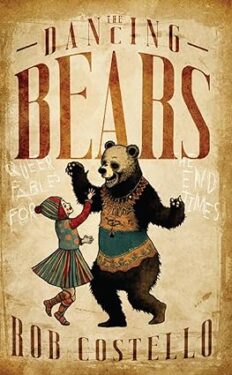 The Dancing Bears
The Dancing Bears Horror, Short Stories
Lethe Press
March 8 , 2024
Kindle
177
Amazon
A lost boy under the spell of a seductive killer suffers the sting of betrayal while on the hunt for fresh blood. A misanthrope obsessed with death carries on a torrid affair with the malevolent spirit haunting the house in his favorite novel. The dead son of an abusive horror novelist returns from the grave to tell his father what really happened the night he died. An ex-child star desperate for a comeback meets a sinister stranger who reveals the terrible price of attaining his heart’s desire. A headstrong girl determined to seduce her ex-boyfriend discovers what being trapped in the closet really means.
The Dancing Bears: Queer Fables for the End Times showcases eleven darkly speculative tales of the queer and uncanny. With eight previously published and three brand new stories, this debut collection features young queer characters grappling with love and desire in a heartless world hurtling toward the abyss.

Review by Gordon Phillips
Member of the Paranormal Romance Guild Review Team
The Dancing Bears, a collection of gay horror stories by Rob Costello, is quite a mixed bag.
Being horror stories it is perhaps not surprising that the prevailing emotions in these stories are negative, but the great predominance of hatred and resentment is sometimes rather oppressive.
The negativity can even become problematic to the point of the very definition of “horror.” The emotion of horror is generally defined as acute fear and disgust or aversion—such as to a ghost or to a serial axe murderer: both represent something threatening and uncanny, that is, outside the norm of experience. This occurs in“Jill,”which might be termed a classic horror story of the non-supernatural sort. Itpresents the reader with a lifestyle so consistently evil and vile, including regular murder and cannibalism, that while the disgust remains acute throughout, the fear aspect abates through sheer repetition, becoming at last merely tiresome and depressing. On the other hand, the story does give a valuable lesson about laying anythingon too thickly.
In terms of truly effective horror, it might be remembered that, while darkness is often said to exist in order to make the light brighter,the same could be said about the reverse.Several of the stories in this collection fail at least partially—i.e., not having the emotional oomph their powerful themes might carry, due to their negative distinction of being completely about things that are rather vile, without any interrupting strayray of light.
Yet, for all the inclusion of some clunkers in this collection it cannot be denied that Rob Costello is a very good writer. When he hits the nail on the head, as he does in several of these stories, the result is something quite magical. And even when a story clunks, there is something thoughtful for the reader to chew over. Whatever his stories’ failings, Costello is never shallow.
Happily, the collection begins and ends strongly. The first story, “Whatever Happened to the Boy who Fell into the Lake?” though very dark, starkly addresses the traditional truths about the sins of the father affecting the next generation, and the limits of love in the face of nightmare horror, and does so quite effectively. The last story, “What We Leave Behind Us,” about searching for peace after the window of opportunity for reconciliation has closed, is both beautiful and haunting. These are stories that will stay long with the reader.
